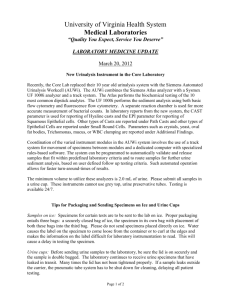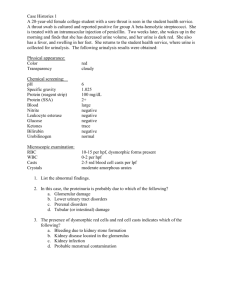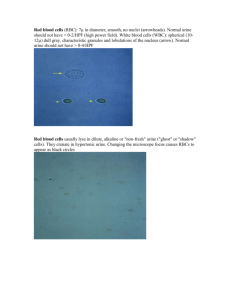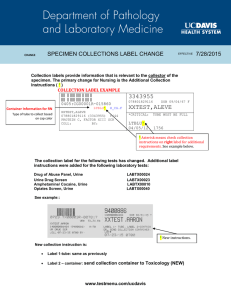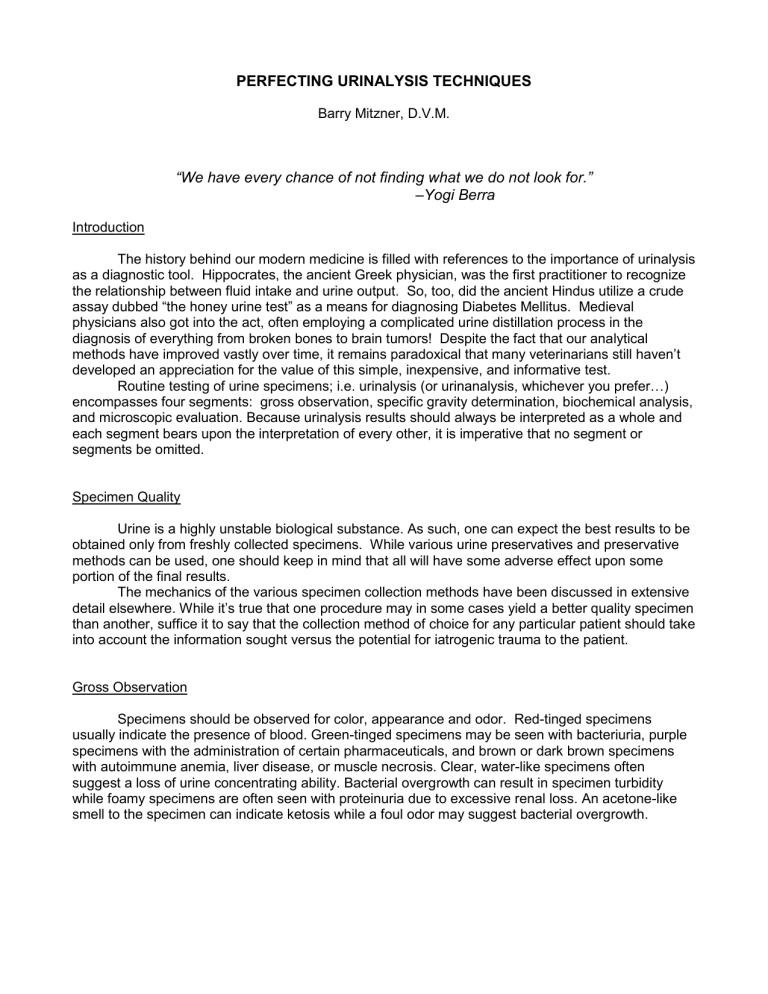
PERFECTING URINALYSIS TECHNIQUES Barry Mitzner, D.V.M. “We have every chance of not finding what we do not look for.” –Yogi Berra Introduction The history behind our modern medicine is filled with references to the importance of urinalysis as a diagnostic tool. Hippocrates, the ancient Greek physician, was the first practitioner to recognize the relationship between fluid intake and urine output. So, too, did the ancient Hindus utilize a crude assay dubbed “the honey urine test” as a means for diagnosing Diabetes Mellitus. Medieval physicians also got into the act, often employing a complicated urine distillation process in the diagnosis of everything from broken bones to brain tumors! Despite the fact that our analytical methods have improved vastly over time, it remains paradoxical that many veterinarians still haven’t developed an appreciation for the value of this simple, inexpensive, and informative test. Routine testing of urine specimens; i.e. urinalysis (or urinanalysis, whichever you prefer…) encompasses four segments: gross observation, specific gravity determination, biochemical analysis, and microscopic evaluation. Because urinalysis results should always be interpreted as a whole and each segment bears upon the interpretation of every other, it is imperative that no segment or segments be omitted. Specimen Quality Urine is a highly unstable biological substance. As such, one can expect the best results to be obtained only from freshly collected specimens. While various urine preservatives and preservative methods can be used, one should keep in mind that all will have some adverse effect upon some portion of the final results. The mechanics of the various specimen collection methods have been discussed in extensive detail elsewhere. While it’s true that one procedure may in some cases yield a better quality specimen than another, suffice it to say that the collection method of choice for any particular patient should take into account the information sought versus the potential for iatrogenic trauma to the patient. Gross Observation Specimens should be observed for color, appearance and odor. Red-tinged specimens usually indicate the presence of blood. Green-tinged specimens may be seen with bacteriuria, purple specimens with the administration of certain pharmaceuticals, and brown or dark brown specimens with autoimmune anemia, liver disease, or muscle necrosis. Clear, water-like specimens often suggest a loss of urine concentrating ability. Bacterial overgrowth can result in specimen turbidity while foamy specimens are often seen with proteinuria due to excessive renal loss. An acetone-like smell to the specimen can indicate ketosis while a foul odor may suggest bacterial overgrowth. Specific Gravity In the normal patient, urine is generally excreted in concentrated form; i.e. >1.030. This finding usually indicates to the diagnostician that the kidneys are functioning properly since one of the typical early signs of renal disease is a loss of concentrating ability and the production of a dilute (isotheunric) specimen. A very dilute specimen (<1.008 ) can be an indicator of mineralocorticoidrelated disease or other malady or it might just be a routine finding in a normal patient. Clinicians should keep in mind that the random aberrant specific gravity reading has little to no significance; especially in an otherwise clinically normal patient. Abnormal specific gravity results which occur repeatedly, however, are cause for concern and further investigation. Urine specific gravity is most easily measured with a refractometer, preferably one that’s temperature compensated. A temperature compensated unit manufactured by Leica Microsystems for veterinary use is currently the only one available with extended ranges for animals. Urinometers (a type of hydrometer) may also be used to measure urine specific gravity although precise testing will require a larger volume of specimen and a keen eye. Some brands of urinalysis strips also include reagent pads which change color in response to specific gravity; however, in the author’s experience these values are less reliable than those determined by refractometric methods. Biochemical Analysis With regard to the use of urinalysis test strips, some basic rules must be followed in order to be assured of meaningful results. The test strip package insert should be thoroughly read and reviewed prior to commencing any patient testing. The insert will not only describe the recommended testing procedure, but will also clearly document optimum measurement times for each color block, analytical limitations for each reagent system, interfering factors, storage recommendations and stability characteristics, and gross indications of product damage. Such vital information can vary from one manufacturer to another, so don’t assume that all strips are alike! As mentioned previously, some test strips made for the human market include indicator pads for specific gravity. These, as well as test pads for leukocytes and nitrite, have demonstrated little utility when used with animal specimens since both false positive and false negative readings may occur clinically. One of the more common biochemical interferences we’ve observed with small animals can result from the presence of ascorbic acid which is produced endogenously in these species. When present in high enough concentration, ascorbic acid can interfere with urine glucose readings (resulting in falsely lowered or negative values) and mask the presence of blood and/or hemoglobin. While some manufacturers have modified the chemical composition of their reagent systems to reduce interference by ascorbic acid, it would appear that no manufacturer has yet to completely eliminate the potential problem. Urine Microscopy Basics One of the longstanding problems associated with examination of urine sediment has been the variability of results which can occur secondarily to variations in test protocol. The method used for specimen collection, the volume of specimen to be spun down for sediment prep, the amount of time and the speed at which that specimen is centrifuged, the volume of solute in which the sediment pellet is resuspended and the thickness of the slide preparation will all affect final results, both qualitatively and quantitatively. To eliminate or at least reduce the profound effects of these variables, this author recommends that practitioner laboratories incorporate one of the disposable, standardized urine sediment evaluation systems (KOVA System; Hycor Biomedical) into the testing protocol. In addition to improving precision, operators will find that these specialized systems will enhance their recognition of the various sediment elements. Adding palatability to an otherwise “dirty” procedure is just an added bonus. The urinary sediment of animals may contain an array of substances or elements. These elements may include metabolic products of the kidney (crystals), blood cells or urogenital tract epithelia, sperm, or proteinaceous substances originating in the kidney (casts). In addition, exogenous elements such as bacteria, fungi, and parasites may be found. Finally, non-pathogenic artifacts, therapeutic or incidental in origin, may also be seen, underscoring the importance of practice in recognizing the various elements for what they are. An easy way to remember these groups of elements is to think of them as the “4 C’s”: Cells Casts Crystals “Critters” Cells There are 3 main types of epithelial cells found in urine sediments of which all are derived from the lining of the kidney and lower urinary tract. Squamous epithelial cells originate from the very distal portions of the tract and may be present in variable numbers depending upon the method of collection. Squamous cells typically appear as large, flattened, and straight-sided with pyknotic central nuclei. Their presence, even in large numbers, is rarely significant; however, malignant forms can occur with squamous cell carcinoma of the urinary tract. Lining the renal pelvis, ureter, urinary bladder, and proximal urethra are cells referred to as transitional cells. These cells are distinguished from squamous cells by their polyhedral to spherical shape, large, centrally-placed spherical nuclei, and balloon-like appearance. While small numbers of transitional cells may be a normal occurrence, large numbers may suggest inflammation, neoplasia, or trauma. Tubular epithelial cells, so named because the are derived from the kidney tubules, are perhaps the most clinically important of the observed cells in that primary kidney disease may result in excess numbers of these cells being sloughed into the urinary sediment. Tubular epithelial cells can be similar in size to transitional cells, sometimes making the two difficult to distinguish morphologically. Differences between the two include the finding that tubular cells tend to have large, vesicular, eccentrically-positioned nuclei, polyhedral shape, decreased nuclear to cytoplasmic ratio, and occasionally villous borders. More importantly, tubular cells do not have the “balloon” appearance so typical of transitional cells. Of the peripheral blood cells found in urine, the neutrophil is the most frequently encountered, easily recognizable by its multi-lobulated nucleus. Neutrophils tend to “ball up” in urine sediments as contrasted with their flattened appearance in blood smears. While small numbers of WBC’s are common in normal specimens and especially with voided specimens, large numbers can be associated with inflammation or infection. Since WBC’s may appear at any inflammatory site throughout the urinary tract, their presence alone does little to localize the lesion. RBC’s can also appear in sediments though small numbers (0-3/HPF) can be a normal finding. Large numbers indicate hemorrhage into the urinary tract, but as with the presence of leukocytes, cannot be used as a localizing finding unless they happen to be a component of a cast. RBC’s are most easily recognized by their biconcave spherical shape and pigmentation. Casts Casts are proteinaceous cylinders which are formed within the kidney itself and are named according to their microscopic appearance. When cells are visualized within the protein matrix of the cast, the cast is named according to the predominant cell type observed; i.e. RBC, WBC, or epithelial although mixed cell casts can also occur. Hyaline casts are composed of congealed protein and have a colorless, smooth, cigar-shaped appearance. Since their size and shape is related to the size of the renal tubular lumen, a widening or broadening of the cast suggests renal tubular dilatation, often viewed as a sign of long-standing renal disease. Like hyaline casts, granular casts may be found in both normal and abnormal patients. They are similar morphologically to hyaline casts although they tend to be more refractile as a result of their granularity. Granules found within these casts may be fine or coarse and scattered throughout or localized to a particular area. Granular casts, like hyaline casts, can also take on a broadened profile with long-standing renal disease. Waxy casts are thought to represent a final form of granular casts and are the most refractile of all casts. They are easily recognized by their many small cracks and broken-off ends. While waxy casts can be a normal finding in small numbers, large numbers usually denote severe and progressive renal disease with decreased renal transit time. It’s also been proposed that certain cast forms might actually represent evolutionary stages of the same cast. For example, granular casts may originate from cellular casts following cell degradation, while waxy casts may represent the final breakdown and confluence of the finest granules. Crystals Crystals are a common finding in most sediment preparations, their presence (or absence) being influenced by specimen handling, temperature, specific gravity, and pH. The finding of some crystalline forms may suggest specific disease conditions such as in the case of oxalate crystals occurring secondary to ethylene glycol (antifreeze) toxicity, while the presence of other forms may be no more than incidental. It’s important, nonetheless, for those wishing to become good urine microscopists to be able to distinguish normal crystals from abnormal forms. Phosphate crystals are among the most commonly observed. They can represent an incidental finding or they may be associated with a disease process such as urinary tract infection. Phosphate crystals can be identified easily by their so described “coffin-lid” appearance although amorphous forms may also be found. . Easily recognized by their characteristic hexagonal shape, Cysteine crystals are a byproduct of aberrant protein metabolism. They can be a frequent finding in certain breeds, especially dachshunds. Ammonium biurate crystals are brownish crystals with a rather distinctive “thorn-apple” shape. Although they are often seen in patients with portal vein anomalies, their presence in small numbers may be considered a normal finding. Bilirubin crystals are most commonly described as “clumps of brown needles” which are joined at the midpoint. They can be a normal finding in dogs or they may be associated with pathologic bilirubinuria. When found in the urine of cats, bilirubin crystals are always a significant finding. Certain drugs such as sulfonamides and iodine-containing compounds (used in radio-contrast studies) can also result in incidental crystalluria. Their presence is noteworthy in that they have the potential to be confused with primary pathologic forms. Critters This final category includes such extra-corporeal elements as bacteria, fungi, and parasites. Bacterial forms are typically found in association with urinary tract infection. When bacteria are observed in the absence of inflammatory cells (WBC’s), however, it’s likely that the specimen became contaminated later on and/or was allowed to incubate for several hours prior to analysis. Fungal hyphae are a rare finding in urinary sediments and an occasional fungal form may be viewed as a contaminant. Findings of larger numbers of organisms, especially in conjunction with inflammatory cells, can be seen in association with mycotic infections which have spread to or involve the urinary tract. Parasite ova are another infrequent sediment finding yet it’s important to be aware of their existence and to be able to differentiate them from some of the common look-alike contaminants. The ova of Capillaria, a tiny threadworm of dogs and other Canidae, may be found in urine sediment although it’s questionable as to whether infection with Capillaria spp. Is associated with any welldefined pathology. Of greater significance are the eggs of the very rare parasite, Dictophyma Renale; common name, “Giant Kidney Worm”. Reporting of Results Each laboratory should establish a standardized protocol for reporting out the results of urine sediment evaluation. At least 10 microscopic fields should be observed for all elements and an average taken with results being recorded in numbers/field. Cellular elements and bacteria are reported in numbers/HPF (high power field) while casts and larger elements are best reported in numbers/LPF. While this protocol can certainly be modified to meet the needs of each individual laboratory, it is paramount that the reporting of results follow an established format each and every time. References and suggested Reading Chew, Dennis J. and Steven P. DiBartola: Interpretation of Canine and Feline Urinalysis, Ralston Purina Company, 1998. Haber, Meryl H.: Urinary Sediment: A Textbook Atlas, ASCP Press 1991. Osborne, Carl A. and Jerry B. Stevens: Handbook of Canine and Feline Urinalysis; Ralston Purina Company, 1981

